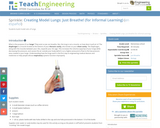
Students build model sets of lungs.
- Subject:
- Engineering and Information Technologies
- Material Type:
- Lesson Plan
- Provider:
- TeachEngineering
- Provider Set:
- TeachEngineering
- Date Added:
- 10/14/2015

Students build model sets of lungs.
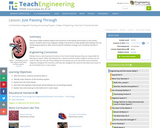
This lesson helps students explore the functions of the kidney and its place in the urinary system. Students learn how engineers design instruments to help people when kidneys are not functioning properly or when environmental conditions change, such as kidney function in space.
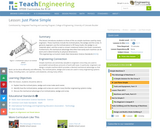
This lesson introduces students to three of the six simple machines used by many engineers. These machines include the inclined plane, the wedge and the screw. In general, engineers use the inclined plane to lift heavy loads, the wedge to cut materials apart, and the screw to convert rotational motion into linear movement. Furthermore, the mechanical advantage describes how easily each machine can do work and is determined by its physical dimensions.
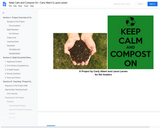
Our planet is precious. Connecting to our world and becoming aware of our surroundings and ways we can keep Earth beautiful can be empowering to students and adults alike! Our goal with this project is to encourage and empower students to reduce waste in our classrooms, our school, our community and beyond!
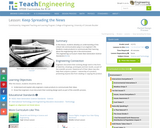
In this lesson, students develop an understanding of the critical role communication plays in an engineer's life. Students create products to communicate their learning about the engineering role in the environment.
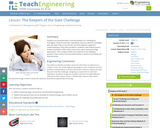
Students are presented with a real-life problem as a challenge to investigate, research and solve. Specifically, they are asked to investigate why salt water helps a sore throat, and how engineers apply this understanding to solve other problems. Students read a medical journal article and listen to an audio talk by Dr. Z. L. Wang to learn more about quantum dots. After students reflect and respond to the challenge question, they conduct the associated activity to perform journaling and brainstorming.
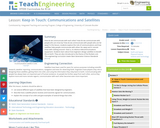
How do we communicate with each other? How do we communicate with people who are close by? How do we communicate with people who are far away? In this lesson, students will explore the role of communications and how satellites help people communicate with others far away and in remote areas with nothing around (i.e., no obvious telecommunications equipment). Students will learn about how engineers design satellites to benefit life on Earth. This lesson also introduces the theme of the rockets curricular unit.
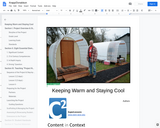
Consistent housing is a continual issue for our community, evidence of this is readily observable in the neighborhoods surrounding our classrooms. Over the course of 15 classroom hours, students will be exploring how they can insulate structures to protect from extreme hot and extreme cold using recycled and/or repurposed materials.
Students will make observations and collect data related to temperature. Student findings will be communicated through science journals, student generated models (charts, 3D structures, drawings, etc.).
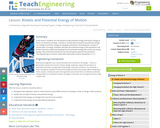
In this lesson, students are introduced to both potential energy and kinetic energy as forms of mechanical energy. A hands-on activity demonstrates how potential energy can change into kinetic energy by swinging a pendulum, illustrating the concept of conservation of energy. Students calculate the potential energy of the pendulum and predict how fast it will travel knowing that the potential energy will convert into kinetic energy. They verify their predictions by measuring the speed of the pendulum.
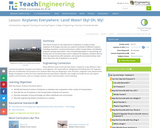
This lesson focuses on the importance of airplanes in today's society. Airplanes of all shapes and sizes are used for hundreds of different reasons, including recreation, commercial business, public transportation, and delivery of goods, among many others. From transporting people to crop-dusting, our society and our economy have come to depend on airplanes. Students will discuss their own experiences with airplanes and learn more about the role of airplanes in our world.

Waste disposal has been an ongoing problem since medieval times. Environmental engineers are employed to develop technologies to dispose of the enormous amount of trash produced in the United States. In this lesson, students will learn about the three methods of waste disposal in use by modern communities. They will also investigate how engineers design sanitary landfills to prevent leachate from polluting the underlining groundwater.
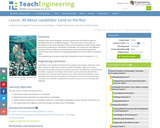
Students learn about landslides, discovering that there are different types of landslides that occur at different speeds from very slow to very quick. All landslides are the result of gravity, friction and the materials involved. Both natural and human-made factors contribute to landslides. Students learn what makes landslides dangerous and what engineers are doing to prevent and avoid landslides.
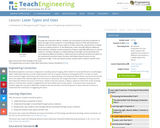
Through two classroom demos, students are introduced to the basic properties of lasers through various mediums. In the Making an Electric Pickle demonstration, students see how cellular tissue is able to conduct electricity, and how this is related to various soaking solutions. In the Red/Green Lasers through Different Mediums demonstration, students see the properties of lasers, especially diffraction, in various mediums. Follow-up lecture material introduces students to the mechanisms by which lasers function and relates these functions to the properties of light. In the associated activity, student teams research specific laser types and present their findings to the class.
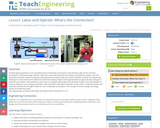
Students gain perspective on the intended purpose of hydraulic accumulators and why they might be the next best innovation for hybrid passenger vehicles. They learn about how hydraulic accumulators and hydraulic systems function, specifically how they conserve energy by capturing braking energy usually lost as heat. Students are given the engineering challenge to create small-scale models from which their testing results could be generalized to large-scale latex tubing for a hydraulic accumulator. After watching a video clip of an engineer talking about his lab-based model to test the feasibility of using an elastomer as an energy accumulator, they brainstorm ideas about how latex can be used in a hydraulic system and how they could test the strength of latex for use in a hydraulic accumulator. The concepts of kinetic energy and energy density are briefly discussed.
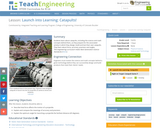
Students learn about catapults, including the science and math concepts behind them, as they prepare for the associated activity in which they design, build and test their own catapults. They learn about force, accuracy, precision and angles.
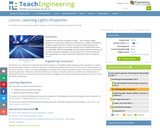
Students learn the basic properties of light the concepts of light absorption, transmission, reflection and refraction, as well as the behavior of light during interference. Lecture information briefly addresses the electromagnetic spectrum and then provides more in-depth information on visible light. With this knowledge, students better understand lasers and are better prepared to design a security system for the mummified troll.
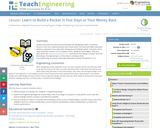
In this lesson, students discover the entire process that goes into designing a rocket for any customer. In prior lessons, students learned how rockets work, but now they learn what real-world decisions engineers have to make when designing and building a rocket. They learn about important factors such as supplies, ethics, deadlines and budgets. Also, students learn about the Engineering process, and recognize that the first design is almost never the final design. Re-Engineering is a critical step in creating a rocket.

This lesson focuses on how to respond professionally to a situation in the workplace, and that attitude is a large component to workplace success. It teachers the difference between hard skills (technical skills) and soft skills (qualities/interpersonal skills) and why soft skills are important to develop.
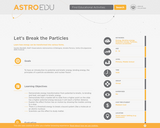
This is a hands-on activity to learn that energy can be transformed into various forms. Potential energy is converted into kinetic energy. Moreover, this kinetic energy can be used (if more than the relative binding energy) to break atoms, particles and molecules to see “inside” and to study their constituents.
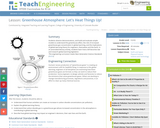
Students observe demonstrations, and build and evaluate simple models to understand the greenhouse effect, the role of increased greenhouse gas concentration in global warming, and the implications of global warming theory for engineers, themselves and the Earth. In an associated literacy activity, students learn how a bill becomes law and research global warming legislation.